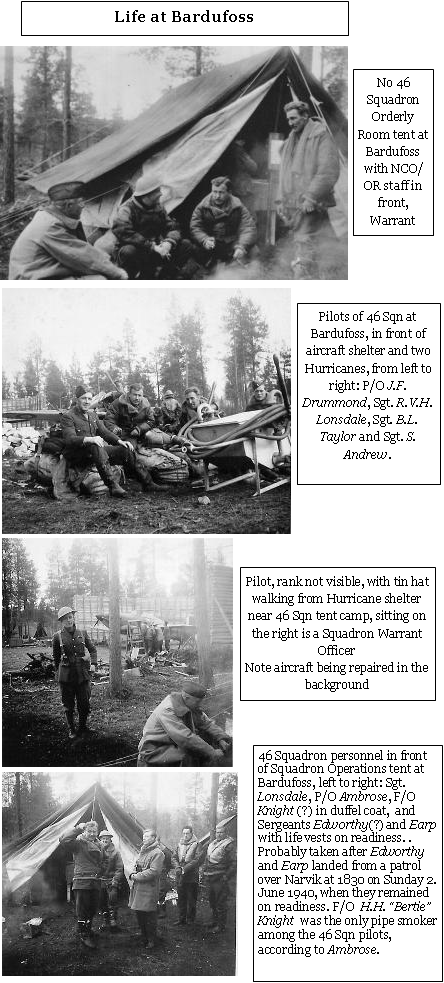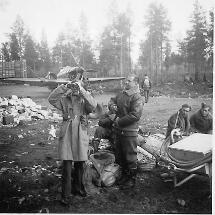
|
No. 46 (F) squadron pilots at Bardufoss on left is heap of empty 4 Imp. Gals. petrol tin cans. Possibly F/O H.H. Knight in duffel coat and using binoculars. Sitting behind on canvas bag is possibly Sgt. Lonsdale with parachute and possible flying suit on canvas bags in front. Standing seems to be Sgt. Earp zipping up his Irving sheepskin flight jacket and behind AM pump cart is Sergeant B.L. Taylor and Sergeant S. Andrew Andrew is easily identifiable from portrait printed on page 442 of “Battle of Britain Then and Now IV”. In background a pilot with Mae West life preserver over flight jacket is walking towards left wingtip of Hurricane having its engine worked on |







|
While I've been waiting for the signal to land Sergeant Taylor said his engine was running very rough and that he would have to land immediately. He made a perfect landing. I came in on the approach at just above stalling speed, feeling my way because the sandbag away down in the tail was affecting the flying characteristics of the aeroplane. Suddenly, as I was getting near the touchdown point, the Hurricane dropped rapidly and it seemed she was turning to land on the quarterdeck below the flight-deck! I slammed on full throttle and that beautiful, lovely Rolls-Royce Merlin engine never faltered. It dragged us up on to the flight deck and the Hurricane and I stopped a quarter of the way along it. When the wind flowing along the deck gets to the run-down it follows the downturn of the deck and causes a terrific down-draught. If you get too low on the approach and are caught in it you are pushed down, and if have not got mighty engine power and quick reactions - that's it. Of course, the Fleet Air Arm pilots were trained to cope with this by doing a fairly steep approach, thereby keeping above the down-draught. Anyway all three of us managed to get down all right and no one used more than three-quarters of the deck. ". Shortly after, seven more Hurricanes landed together with ten Gladiators from 263 Sqn. The Commander of Glorious was Captain Guy D'Oyly-Hughes. He was in a hurry to get home to start making preparations for a court-martial against his Commander of Flying. He received permissions to part company from the rest of the naval force and proceed to Scapa Flow escorted by two destroyers, leaving Ark Royal and her screen of destroyers behind. For unknown reasons Glorious did not use its Swordfish planes to patrol ahead and on the flanks. Glorious was intercepted and sunk by the battle-cruisers Scharnhorst and Gneisenau 200 miles of the Norwegian coast just north of the Arctic Circle. The destroyers were also sunk. Out of a total of over 1500 men only 41 survived. Jameson and Cross survived three days on a float before being rescued by a Norwegian ship. In their ten day Norwegian campaign 46 Sqn. flew 330 hours and 240 missions. They lost two of their 23 pilots in combat. Eight more pilots lost their lives in the Glorious tragedy. Three Hurricanes were shot down and three left behind at Bardufoss. The two damaged planes at Skånland were salvaged and brought home by ship. Sources and Acknowledgements: · RAF Operations Record Book, Forms 540 and 541 of No 46 Squadron. · "FLYALARM" by Ulf Larsstuvold, Bjorn Olsen, Bjorn Hafsten and Sten Stenersen. · "Jamie" Jameson · Interviews with locals in the Narvik area. · "Fledgling Eagles " by Christopher Shores, with John Foreman, Christian-Jacques Earnhardt, Heinrich Weiss and Bjorn Olsen · "Straight and Level " by ACM Sir Kenneth Cross with Professor Vincent Orange. · "Carrier Glorious " by John Winton. · Ovine Ellingson original article · The family of Fg Off Drummond for many of the pictures in this article |